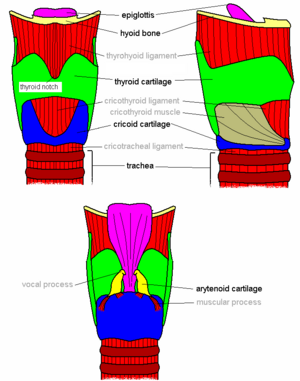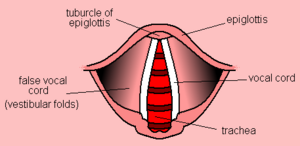Larynx
Structure and Function
Structure
The larynx starts where the epiglottis meets the pharynx, and ends at the top of the trachea. In front of it are the thyroid and parathyroid glands. It is composed of several irregularly shaped cartilages:
- 1 thyroid cartilage – big one at the front with a "thyroid notch"
- 1 cricoid cartilage – one at the bottom.
- 2 arytenoid cartilages – sort of triangular, on top of cricoid; the vocal cords are attached to them.
- 1 epiglottis – fibroelastic cartilage at the top.
The muscles of the larynx are in two groups, extrinsic and intrinsic:
- Extrinsic: elevate and depress the larynx (move it up and down) during and after swallowing. Because the thyroid cartilage is attached to the hyoid bone, the movements of the hyoid bone are followed by those of the larynx.
- Intrinsic: two groups, those that prevents food entering the larynx during swallowing, and those that move the vocal cords. The first group is basically all about moving the epiglottis. The others are split into the cricothyroid, which is on the side of the cricoid cartilage and controlled by the external laryngeal nerve, and the arytenoids ones (there's about 4) which are controlled by the recurrent laryngeal nerve.
Functions
- Production of Sound
- Pitch depends of length and tightness of the chords (they are longer in adult men).
- Volume depends on force of vibration, which is relative to expired air.
- Resonance and tone is relative to shape of mouth, lips, tongue, face and the air in the paranasal sinuses.
- Protection of the lower respiratory tract: the epiglottis prevents massive chunks of sandwich and the like passing down into the lungs.
- Passageway of air: obviously.
- Warming moistening and filtering air: as per rest of upper tract.
Arterial and Venous supply
The superior thyroid artery is related to the external laryngeal nerve, and the inferior thyroid artery is related to the recurrent laryngeal nerve. So don't play around with them too much or your patient won't be able to talk.
Nervous Supply
The sensory supply to the mucous membrane above the two vocal folds is from superior laryngeal branch of the vagus. Below the folds it is supplied by the recurrent laryngeal nerve.
The motor supply to the intrinsic muscles is the recurrent laryngeal nerve, except the cricothyroid muscle, superior laryngeal.
Lymph
Not very much lymph, which is good since it prevents cancer spread.
Histology
Like most of the respiratory tract, its mostly non-keratinized ciliated columnar epithelium.
Clinical Conditions
Lesions of laryngeal nerves
Any operation on the thyroid can risk damage to the recurrent and external laryngeal nerves. This is generally a bad idea. The nerves may be affected by malignant involvement of the deep cervical nodes also.
Laryngitis
Inflammation of the larynx and/or vocal cords. It may occur in association with viral or bacterial inflammation of trachea and bronchi. Diptheria was once a common and serious bacterial cause of laryngitis, forming a fibrinopurulent (fibrous with pus in it) membrane that obstructed airways. If associated with an allergen there can be gross oedema causing airway obstruction. Breathing can be difficult, voice may be horse and there is a honking cough.
Epiglottitis
Inflammation of the epiglottis. The child will be obviously unwell since it will be from a systemic infection, spreading to the epiglottis. Happily its rare since the HIb vaccine began, since its caused by haemophilus influenzae type B. It can lead to airway obstruction and sometime a tracheostomy may be necessary.
The key and important thing to remember' is: if you suspect epiglottitis, do not go anywhere near the child's throat until you have an anaesthetist nearby. Otherwise it can close up and the child can die. Something to avoid...
Laryngeal polyps
Often referred to as singer's nodes. Connective tissue with squamous mucosa forming on the vocal cords. Even when only a few millimetres in diameter they can alter the character of the voice.
Papilloma
Caused by human papillomavirus. They are benign tumours or papillomatous squamous epithelium with fibrovascular cores of stroma. They may be multiple and recurrent, especially in children, by are usually single in adults. They can extend into the trachea and bronchi. Have to be removed surgically, but they often come back.
Squamous cell carcinoma
Usually preceded with a degree of dysplasia. You get it if a) you sit in your shed sawing up asbestos ceiling tiles and gleefully inhaling the dust, or b) you choose to suck on rolled up burning carcinogenic leafs 20 times a day. Most carcinomas arise on the vocal cords. Symptoms are hoarseness of voice and later, pain, haemoptysis and dysphagia. Treatment is by resection and/or radiotherapy.


